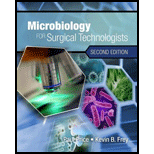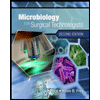
We are a product of our genes, so they say; however, we are also populated by microbes. Some we cannot do without, but others wait around until our defenses are down and then they strike. During your examination of the topics in this chapter, consider the following:
Which characteristics of bacterial cells allow them to cause disease in humans?
To determine: The characteristics of bacteria cells that allow them to cause disease in humans.
Introduction: Prokaryotes are the oldest form of life on Earth that belongs to the domain Archaea and bacteria. They are single-celled microscopic organisms and they do not possess true nucleus or membrane-bounded organelles. The prokaryotes are found to be both beneficial as well as harmful to humans.
Explanation of Solution
The bacterial cells possess certain characteristics that make them cause infections or diseases in humans. The virulence factors are the characteristics of the bacteria that enhance its ability to cause disease. The cell structure of the bacteria acts as the virulence factors that include: LPS (lipopolysaccharide), S-layer, mycolic acid, fimbria, capsule, pili, and endospores.
Want to see more full solutions like this?
Chapter 4 Solutions
Microbiology for Surgical Technologists (MindTap Course List)
- Explain in a small summary how: What genetic information can be obtained from a Punnet square? What genetic information cannot be determined from a Punnet square? Why might a Punnet Square be beneficial to understanding genetics/inheritance?arrow_forwardIn a small summary write down:arrow_forwardNot part of a graded assignment, from a past midtermarrow_forward
- Noggin mutation: The mouse, one of the phenotypic consequences of Noggin mutationis mispatterning of the spinal cord, in the posterior region of the mouse embryo, suchthat in the hindlimb region the more ventral fates are lost, and the dorsal Pax3 domain isexpanded. (this experiment is not in the lectures).a. Hypothesis for why: What would be your hypothesis for why the ventral fatesare lost and dorsal fates expanded? Include in your answer the words notochord,BMP, SHH and either (or both of) surface ectoderm or lateral plate mesodermarrow_forwardNot part of a graded assignment, from a past midtermarrow_forwardNot part of a graded assignment, from a past midtermarrow_forward
 Microbiology for Surgical Technologists (MindTap ...BiologyISBN:9781111306663Author:Margaret Rodriguez, Paul PricePublisher:Cengage Learning
Microbiology for Surgical Technologists (MindTap ...BiologyISBN:9781111306663Author:Margaret Rodriguez, Paul PricePublisher:Cengage Learning Comprehensive Medical Assisting: Administrative a...NursingISBN:9781305964792Author:Wilburta Q. Lindh, Carol D. Tamparo, Barbara M. Dahl, Julie Morris, Cindy CorreaPublisher:Cengage Learning
Comprehensive Medical Assisting: Administrative a...NursingISBN:9781305964792Author:Wilburta Q. Lindh, Carol D. Tamparo, Barbara M. Dahl, Julie Morris, Cindy CorreaPublisher:Cengage Learning Human Heredity: Principles and Issues (MindTap Co...BiologyISBN:9781305251052Author:Michael CummingsPublisher:Cengage LearningEssentials Health Info Management Principles/Prac...Health & NutritionISBN:9780357191651Author:BowiePublisher:Cengage
Human Heredity: Principles and Issues (MindTap Co...BiologyISBN:9781305251052Author:Michael CummingsPublisher:Cengage LearningEssentials Health Info Management Principles/Prac...Health & NutritionISBN:9780357191651Author:BowiePublisher:Cengage





